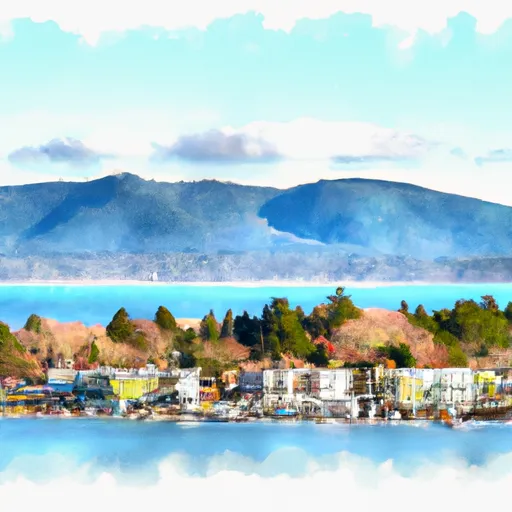-
 Snoflo Premium
Snoflo Premium
Get unlimited access to all our content
With no Ad interruptions! - Start Your Free Trial Login with existing account
Lummi-Island
Eden Index
Climate
7.7
•
Recreation
3.1
•
Community
3.1
•
Safeguard
4.9/10

Lummi Island is a charming gem located in the northwest corner of Washington state, nestled in the Salish Sea. The island enjoys a mild and temperate climate, with warm summers and cool, wet winters. The average temperature ranges from the mid-40s°F (7°C) in winter to the mid-70s°F (24°C) in summer, making it pleasant for outdoor activities throughout the year.
As for hydrology constituents, Lummi Island boasts pristine coastal waters and is home to diverse marine life. The surrounding Salish Sea is famous for its rich ecosystem, attracting nature enthusiasts and wildlife lovers. Kayaking, boating, and fishing are popular activities, allowing visitors to explore the island's breathtaking coastline and observe seals, eagles, and even orcas.
On land, Lummi Island offers numerous outdoor recreation opportunities. Hiking trails wind through dense forests, leading to stunning viewpoints showcasing the surrounding islands and majestic Mount Baker. The island also features several public beaches, perfect for strolling, picnicking, or beachcombing.
In conclusion, Lummi Island's mild climate, pristine coastal waters, and diverse outdoor recreation opportunities make it an idyllic destination for nature lovers seeking adventure and tranquility in the heart of the Salish Sea.
What is the Eden Index?
The Snoflo Eden Index serves as a comprehensive rating system for regions, evaluating their desirability through a holistic assessment of climate health, outdoor recreation opportunities, and natural disaster risk, acknowledging the profound impact of these factors on livability and well-being.
Climate Health Indicator (CHI): 7.7
Lummi-Island receives approximately
902mm of rain per year,
with humidity levels near 82%
and air temperatures averaging around
10°C.
Lummi-Island has a plant hardyness factor of
8, meaning
plants and agriculture in this region tend to thrive here all year round.
By considering the ideal temperature range, reliable water supplies, clean air, and stable seasonal rain or snowpacks, the Climate Health Indicator (CHI) underscores the significance of a healthy climate as the foundation for quality living.
A healthy climate is paramount for ensuring a high quality of life and livability in a region, fostering both physical well-being and environmental harmony. This can be characterized by ideal temperatures, reliable access to water supplies, clean air, and consistent seasonal rain or snowpacks.
Weather Forecast
Streamflow Conditions
Puget Sound
Area Rivers
Puget Sound
Snowpack Depths
Puget Sound
Reservoir Storage Capacity
Puget Sound
Groundwater Levels
Recreational Opportunity Index (ROI): 3.1
The Recreational Opportunity Index (ROI) recognizes the value of outdoor recreational options, such as parks, hiking trails, camping sites, and fishing spots, while acknowledging that climate plays a pivotal role in ensuring the comfort and consistency of these experiences.
Access to outdoor recreational opportunities, encompassing activities such as parks, hiking, camping, and fishing, is crucial for overall well-being, and the climate plays a pivotal role in enabling and enhancing these experiences, ensuring that individuals can engage in nature-based activities comfortably and consistently.
Camping Areas
| Campground | Campsites | Reservations | Toilets | Showers | Elevation |
|---|---|---|---|---|---|
| Larrabee State Park | 75 | 134 ft | |||
| Bay View State Park | 80 | 37 ft |
Nearby Ski Areas
Catastrophe Safeguard Index (CSI):
The Catastrophe Safeguard Index (CSI) recognizes that natural disaster risk, encompassing floods, fires, hurricanes, and tornadoes, can drastically affect safety and the overall appeal of an area.
The level of natural disaster risk in a region significantly affects safety and the overall livability, with climate change amplifying these risks by potentially increasing the frequency and intensity of events like floods, fires, hurricanes, and tornadoes, thereby posing substantial challenges to community resilience and well-being.
Community Resilience Indicator (CRI): 3.1
The Community Resilience Indicator (CRI) recognizes that education, healthcare, and socioeconomics are crucial to the well-being of a region. The CRI acknowledges the profound impact of these elements on residents' overall quality of life. By evaluating educational resources, healthcare accessibility, and economic inclusivity, the index captures the essential aspects that contribute to a thriving community, fostering resident satisfaction, equity, and social cohesion.

